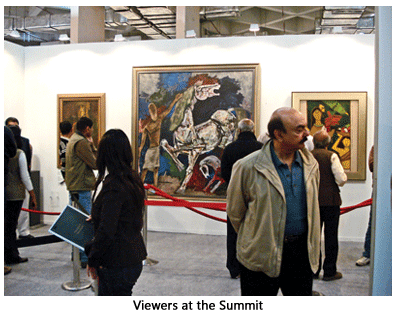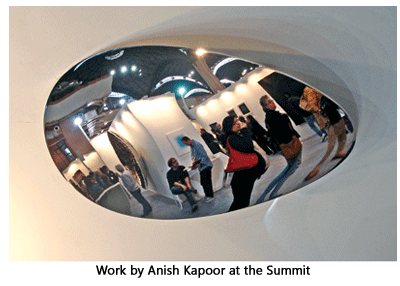- Prelude
- Editorial
- Subodh's 'return home'
- A Conversation with TV Santosh
- It's a War Out There
- Raqib Shaw
- Illusions in Red from a very British Indian Sculptor
- Stand Alone: Shibu Natesan
- Reading Atul Dodiya
- Bharti Kher: An Obsession for Bindis
- Bose Krishnamachari
- The Image - Spectacle and the Self
- From Self-depiction to Self-reference: Contemporary Indian Art
- GenNext: The Epitome of New Generation Art
- Kolkata's Contemporary Art A Look in the Mirror
- Innovation Coalesced with Continuing Chinese Qualities
- Kala Bhavana-Charukala Anushad Exchange Program
- Montblanc Fountain Pens
- Dutch Designs: The Queen Anne Style
- Bangalore Dance Beat
- Decade of change
- Distance Between Art & It's Connoisseur
- What Happened and What's Forthcoming
- 3rd India Art Summit
- New Paradigms of the Global Language of Art
- Black Brown & The Blue: Shuvaprasanna
- Art Events Kolkata
- Musings from Chennai
- Art Bengaluru
- Printmaker's Season
- Mumbai Art Sighting
- The Pause of Profound Stillness
- Previews
- In the News
- The Rebel Queen: An icon of her own times yet looked down upon
ART news & views
New Paradigms of the Global Language of Art
Volume: 3 Issue No: 14 Month: 3 Year: 2011
by Saba Gulraiz
The month of January was all pulsating with the art activities in the capital. It was not only the Pragati Maidan that was full of activity, other art destinations also set in motion to coincide with it their showings, including an exhibition of Yusuf Arakkal's works at Gallery Art Alive, Portrait of an Artist, an exhibition of sculptures at Dhoomimal, Yeh Image Mahan–India meets Bharat, curated by Rakhi Sarkar at Lalit Kala Academi, Rabindra Bhawan. An exhibition from the Kiran Nadar Museum of Art collection also made an important headline of the month. Amidst rounds of cocktails India Art Summit kick-started with its third edition on 20th January, 2011. The event provided the kind of stimulus needed to create the right atmosphere in a rather dull backdrop of recession. This time the event, with an unprecedented magnitude, pulled together 570 artists, 84 participating galleries and around 80 thousand visitors from across the world. The summit caught the attention of the whole art fraternity  alike--art collectors, art connoisseurs, critics, art lovers apart from other luminaries of art including S H Raza who has finally come back after living in France for a better part of his life.
alike--art collectors, art connoisseurs, critics, art lovers apart from other luminaries of art including S H Raza who has finally come back after living in France for a better part of his life.
The occasion offered an opportunity to enlarge our sensibility of understanding various aspects of modern and contemporary art from across the world. The summit helped exploring a possible place to witness the diverse art scene with engaging and memorable collections from some of the renowned national and international galleries including works from artists of great merit like Pablo Picasso, Joan Miró, André Masson to Husain, Raza, Tyeb Mehta to the young masters like Subodh Gupta, Anish Kapoor, Atul Dodiya to still younger and emerging artists. Throwing a wide glance on this multivalent global art scene one can easily discern the changes taken place over the decades. What has accelerated these changes is the current of globalization and modernization which produced ripples in the art world. Science and technology, the agent of these changes, has expanded the areas of expression in the form of new media art encompassing video art, digital art, performance and installation etc. This epoch-making transformation has not only expanded the area of expression but it has also made the contemporary art accessible and affordable to more.
Today's artist is not retrogressive in the sense that he feels himself a part of global growth. His art echoes the demands of the time along with the consciousness of his own place in the time of his contemporaneity. This consciousness takes his art inexorably towards present pursuits of the complex and cluttered world he is living in. Many works exhibited in the India Art Summit typify this fact where artists seemed to have felt the pulse of the changed environment along with their own need to speak in a global language. They strived to create a global art language not only for the reception of the wider audiences but to gain access to the international art market. Contemporary artists are breaking them free from the conflicts and contradictions of what is national or international, traditional or modern. They are searching for a plural identity. For their inspiration they no more look at the older disciplines. Their inspirational debt goes to modern civilization and technology where the line that bifurcates the Indian from the Western gets blurred. This global language has also widened the scope for using modern materials of a consumerist society. They feel no inhibitions for the use of all odds and ends coming from a cityscape. It was quite visible in the summit as how artists have freed themselves from the boundaries of conventional materials by using assorted things of everyday life like magnet, ribbons, microphones, wires, steel etc. In between such works, the works which stood distinct were Anish Kapoor's. His concave mirrors of stainless steel, resplendent with dazzling light, were the major centre of attraction. What amused visitors were their diffused reflections forming Kaleidoscopic patterns. His on going exhibition at National Gallery of Modern Art was also much to the delight of the viewers. Here one could see some of his best engineered works including relief carving and wax installations. Among other artists who have given a brave new face to Indian art by keeping pace with the modern times were Subodh Gupta,  Jitish Kallat, and Atul Dodiya. Our very first visual encounter at the summit was with Subodh's golden pots loaded heavily on a rickshaw at the entrance gate, and then in the hall it was his installation of Tiffin boxes. What a rare balance these Tiffin boxes of stainless steel maintained while moving on a conveyer belt! Subodh's shiny utensils fascinate many young artists, the examples of which could be seen at other booths. One more example of moving installation was seen at another booth where a carriage was continuously moving on the tracks with a corresponding sound track- reminds one of the industrial noises. The artist seemed to reveal the chaotic journey of his mind where the machine really has come to take away the quietude from man's life. In this aesthetic fashion of time technology has assumed an important place but the confusion that the fusion of technology and art creates, baffles our minds and leaves us in complete bewilderment. I am no Luddite to oppose technology so long as it doesn't vitiate the visual appeal of an artistic work and denigrate it into another commodity of consumerist society. The summit also provided a sufficient exposure to the arts that are culled out from popular new media.
Jitish Kallat, and Atul Dodiya. Our very first visual encounter at the summit was with Subodh's golden pots loaded heavily on a rickshaw at the entrance gate, and then in the hall it was his installation of Tiffin boxes. What a rare balance these Tiffin boxes of stainless steel maintained while moving on a conveyer belt! Subodh's shiny utensils fascinate many young artists, the examples of which could be seen at other booths. One more example of moving installation was seen at another booth where a carriage was continuously moving on the tracks with a corresponding sound track- reminds one of the industrial noises. The artist seemed to reveal the chaotic journey of his mind where the machine really has come to take away the quietude from man's life. In this aesthetic fashion of time technology has assumed an important place but the confusion that the fusion of technology and art creates, baffles our minds and leaves us in complete bewilderment. I am no Luddite to oppose technology so long as it doesn't vitiate the visual appeal of an artistic work and denigrate it into another commodity of consumerist society. The summit also provided a sufficient exposure to the arts that are culled out from popular new media.
Among the projects done with Pop themes, Ketna Patel's reincarnated Nano car was one of the major attractions for the visitors. These projects along with other Pop arts offered a convenient visual to engage us momentarily in the parodies of our immediate world. Will any one ask the legitimate question of their sustainability? It is true that an artist can not remain insensitive to his immediate world. The banalities of modern city life offer him a wide range of concepts. The diverse range of images of urban, social and political conditions reveals his consciousness and concern for his contemporary world. Scores of works exhibited at the fair can be read as the parable of modern life and its concerns in the form of quirky images of human pathos, humour and other photorealistic images of common place realities. In these paradigm shifts pure aesthetic qualities of visual art seem to have been compromised where material, concept and technology have taken the upstage. However, amidst multitudinous arts, monumental pieces, the elfin magic of the two dimensional art retrieved the viewers to those relentless masters of modern art who still rule the soul and heart of the entire art world.